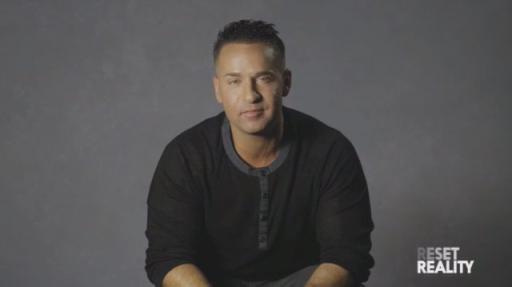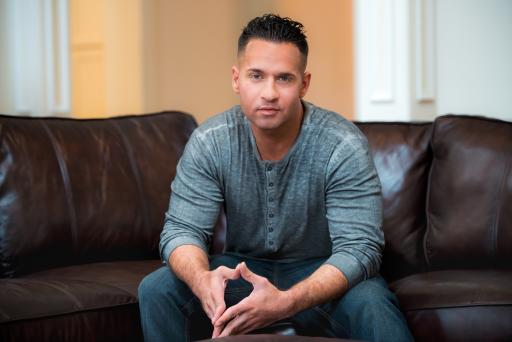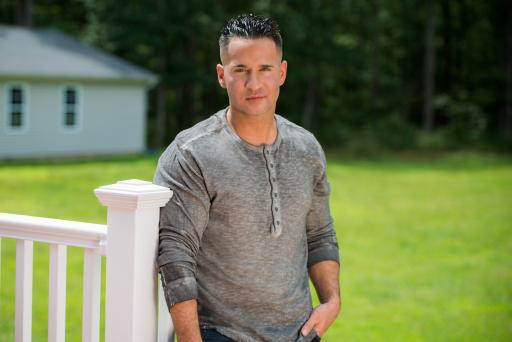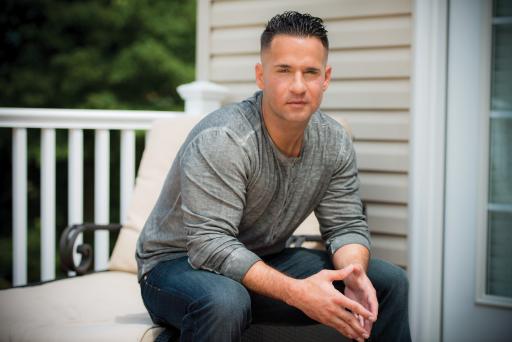|
Media Contacts: |
|
|
Alana Rockland |
Alice Sofield |
Michael “The Situation” Sorrentino Partners With Community Ambassadors to Show the Reality of Opioid Prescription Painkiller Addiction and Motivate Americans Battling the Disease to “Reset Reality”
New Public Health Initiative Helps Reveal the Real Situation About Growing National Epidemic
RICHMOND, Va. (September 10, 2013) – Michael “The Situation” Sorrentino today helped launch a new public health initiative titled “Reset Reality” designed to increase knowledge and understanding of the prevalence, science and treatment of opioid prescription painkiller addiction – a condition he personally struggled with until finally seeking help in 2012. Working in partnership with Reckitt Benckiser Pharmaceuticals Inc. and community ambassadors from across the country who are also successfully managing the disease, the group hopes to get the word out that people don’t have to face the fight alone and can help to reset their situation by working with a doctor to manage prescription painkiller addiction. Together, they hope to offer inspiration by sharing their stories of recovery publically, along with much needed education and information that can be found on the new resource hub, ResetReality.com.
America is facing a growing epidemic: prescription painkiller addiction is an equal opportunity disease, affecting individuals of all ages, genders, races and socioeconomic status. Each year for the last 11 years, the number of people battling this addiction has increased. Today, prescription painkiller addiction – also known as opioid dependence – affects millions of Americans. Sadly, it is often a common gateway to heroin and other drug addictions. While opioid prescription painkillers can be effective medicines, some people develop a dependence as an unexpected consequence of proper pain treatment. Over time, opioid prescription painkillers can alter the brain’s chemistry by “resetting” the brain so one begins to feel they need opioid prescription painkillers just to get through the day. People living with prescription painkiller addiction often feel isolated and fear being judged or relapsing, causing them to not seek help.
“People think they know me from what they saw on reality TV, but they didn’t see the real situation with my prescription painkiller addiction. Fortunately, with the strong support of my family, I was able to get the help I needed and find a path forward to help maintain my recovery,” Michael said. “I’ve learned a lot on my recovery journey, both about myself and this particular addiction. Prescription painkiller addiction needs to be managed like any other medical condition: with a commitment to lifestyle changes, treatment and surrounding yourself with a supportive environment. And I want people to know that no matter what the situation, a healthy and positive recovery can be possible.”
Michael has found that a daily medication that he took in rehab and now takes daily by prescription from his doctor called SUBOXONE® (buprenorphine and naloxone) Sublingual Film (CIII) along with counseling has worked best for him. Through the initiative, the public is encouraged to work with a doctor, like the “Reset Reality” ambassadors did, to determine what treatment program will work best for them or a loved one.
Community support and understanding is instrumental to help encourage the untreated to seek help. A recent national survey*† revealed both U.S. adults and primary care doctors harbor a variety of misperceptions and stereotypes about opioid dependence that may impact the way the disease – and those living with it – are treated. For example, more than two-thirds (68 percent) of adults and eight-in-ten doctors (80 percent) surveyed say opioid dependence represents a mental health problem, and nearly half of adults (45 percent) and almost one-third of doctors (30 percent) believe opioid dependence is more of a psychological problem (e.g., lifestyle choice) rather than a physical illness (e.g., chronic disease). Yet, two-thirds of adults (67 percent) and more than one-third of doctors (35 percent) feel like they do not know much about opioid dependence. And another 11 percent of adults and 3 percent of doctors believe opioid dependence refers to addiction of any kind of drug. Conducted in March 2013 by Harris Interactive, the survey was commissioned by Reckitt Benckiser Pharmaceuticals, the sponsors of “Reset Reality.”
“Although often stigmatized as simply bad behavior, prescription painkiller addiction is a real medical disease. Similar to other lifelong conditions like diabetes and asthma, prescription painkiller addiction is not presently considered curable. It can be successfully treated and controlled,” said Adam Rubinstein, M.D., Advocate Condell Medical Center in Libertyville, Ill. and NorthShore University HealthSystem in Evanston, Ill. “Reset Reality aims to correct misperceptions about opioid dependence, as well as create urgency and action among Americans living with the disease to learn about the chronic nature of the illness, individualized treatment options and quite simply, how to access help.”
ResetReality.com Offers Education,
Resources and Ways to Get Involved
In addition to speaking appearances in cities across the country by Michael and the community ambassadors, the ResetReality.com website is an integral part of the public awareness effort. The website provides an online destination for people to learn about treatment and take action to help themselves or someone else – as well as to lend support to broader community awareness. Visitors can access information and tools that address opioid dependence, including a symptom screener and how to find a doctor that is certified to treat opioid prescription painkiller and heroin addiction.
People will also find the personal stories from the community ambassadors about their decision to reset their reality and ongoing efforts to manage their opioid dependence today. To get involved in the initiative, the public can share their reality of successfully battling addiction or show support for anyone who is trying to change their addiction situation by providing inspirational words, downloading the campaign badge from the website or using #ResetReality on Facebook or Twitter.
About Opioid Dependence
Often stigmatized as bad behavior, poor judgment and a moral failing on the part of the patient, opioid dependence – also known as prescription painkiller or heroin addiction – is a chronic disease caused in part by pervasive changes in the brain’s chemistry that can result from regular use of opioids, such as oxycodone, morphine and heroin.1,2,3 These long-lasting changes can interfere with normal brain functioning, fooling the brain into thinking the opioid is necessary for survival and resulting in drug-seeking behavior and dependence.1,2,3 Similar to other chronic diseases, such as diabetes and hypertension, opioid dependence requires continued medical care and monitoring in order to manage it successfully and can be fatal if left untreated.1,2,3
Opioid dependence has grown to epidemic proportions – affecting men and women of all ages, races, ethnic groups and educational levels – and currently represents a national health crisis.4 As of 2011, approximately 1.8 million people were living with pain reliever dependence or abuse,5 but only 40 percent of these individuals were receiving proper treatment for the disease.6
About SUBOXONE® Sublingual Film (CIII)
SUBOXONE Film, approved by the U.S. Food and Drug Administration (FDA) in 2010, is a trusted and proven treatment option for opioid dependence that allows patients to be discreetly treated in the privacy of a physician’s office. Because SUBOXONE Film is approved for at-home use, individuals living with opioid dependence can continue their daily lives while under a physician’s care similar to other chronic diseases, such as diabetes, asthma or hypertension.
SUBOXONE Film combines buprenorphine and naloxone in a 4:1 ratio and is available in 2 mg/0.5 mg, 4 mg/1 mg, 8 mg/2 mg and 12 mg/3 mg dosage formulations. Buprenorphine is a partial opioid agonist that strongly binds to the opioid receptors in the brain and dose-dependently blocks other opioids from attaching. In doing so, buprenorphine helps reduce opioid use and may increase treatment retention by helping to manage withdrawal symptoms and reducing cravings. SUBOXONE Film also includes naloxone, an opioid agonist, that can cause opioid withdrawal when injected by a person dependent on full agonist opioids and is intended to help minimize its attractiveness for deliberate misuse. When SUBOXONE Film is taken as prescribed (i.e. dissolved under the tongue) the naloxone has no effect.
It is estimated that more than four million Americans living with opioid dependence have been treated with the active ingredients contained in SUBOXONE Film since the combination was first approved in tablet formulation by the FDA in 2003.
About Reckitt Benckiser Pharmaceuticals Inc.
Reckitt Benckiser Pharmaceuticals Inc. is a specialty pharmaceutical company with a decade of heritage in serving the opioid dependence community. Committed to expanding education and access to medical therapies, the company innovates, manufactures and markets medications that, in conjunction with counseling and psychosocial support, treat opioid dependence. Reckitt Benckiser Pharmaceuticals Inc. continues to invest resources in raising awareness of opioid dependence within the community, whilst also sponsoring training programs for doctors to become certified to treat opioid addicted patients. The company aims to help patients, while also protecting communities from the financial and societal burdens of addiction through mediation-assisted treatment, enabling opioid dependence to be managed within mainstream medical practice. Reckitt Benckiser Pharmaceuticals Inc. is a wholly owned subsidiary of Reckitt Benckiser Group plc, a global company publicly traded on the UK stock exchange.
Indication
SUBOXONE® (buprenorphine and naloxone) Sublingual Film (CIII) is a prescription medicine used for maintenance treatment of opioid dependence as part of a complete treatment plan to include counseling and behavioral therapy.
Important Safety Information
Do not take SUBOXONE Sublingual Film if you are allergic to buprenorphine or naloxone as serious negative effects, including anaphylactic shock, have been reported.
SUBOXONE Sublingual Film can be abused in a manner similar to other opioids, legal or illicit.
SUBOXONE Sublingual Film contains buprenorphine, an opioid that can cause physical dependence with chronic use. Physical dependence is not the same as addiction. Your doctor can tell you more about the difference between physical dependence and drug addiction. Do not stop taking SUBOXONE Sublingual Film suddenly without talking to your doctor. You could become sick with uncomfortable withdrawal symptoms because your body has become used to this medicine.
SUBOXONE Sublingual Film can cause serious life-threatening breathing problems, overdose and death, particularly when taken by the intravenous (IV) route in combination with benzodiazepines or other medications that act on the nervous system (ie, sedatives, tranquilizers, or alcohol). It is extremely dangerous to take nonprescribed benzodiazepines or other medications that act on the nervous system while taking SUBOXONE Sublingual Film.
You should not drink alcohol while taking SUBOXONE, as this can lead to loss of consciousness or even death.
Death has been reported in those who are not opioid dependent.
Your doctor may monitor liver function before and during treatment.
Keep SUBOXONE Sublingual Film out of the sight and reach of children. Accidental or deliberate ingestion of SUBOXONE Sublingual Film by a child can cause severe breathing problems and death.
Do not take SUBOXONE Sublingual Film before the effects of other opioids (eg, heroin, hydrocodone, methadone, morphine, oxycodone) have subsided as you may experience withdrawal symptoms.
Injecting SUBOXONE may cause serious withdrawal symptoms such as pain, cramps, vomiting, diarrhea, anxiety, sleep problems, and cravings.
Before taking SUBOXONE, tell your doctor if you are pregnant or plan to become pregnant. If you become pregnant while taking SUBOXONE, alert your doctor immediately as there may be significant risks to you and your baby; your baby may have symptoms of withdrawal at birth. If you are pregnant or become pregnant while taking SUBOXONE, you should report it using the contact information provided below.*
Before taking SUBOXONE, talk to your doctor if you are breast-feeding or plan to breast-feed. SUBOXONE can pass into your milk and may harm the baby. Talk to your doctor about the best way to feed your baby if you take SUBOXONE. Breast-feeding is not recommended while taking SUBOXONE.
Do not drive, operate heavy machinery, or perform any other dangerous activities until you know how SUBOXONE affects you. Buprenorphine in SUBOXONE can cause drowsiness and slow reaction times during dose-adjustment periods.
Common side effects of SUBOXONE Sublingual Film include nausea, vomiting, drug withdrawal syndrome, headache, sweating, numb mouth, constipation, painful tongue, redness of the mouth, intoxication (feeling lightheaded or drunk), disturbance in attention, irregular heartbeat, decrease in sleep, blurred vision, back pain, fainting, dizziness, and sleepiness.
This is not a complete list of potential adverse events associated with SUBOXONE Sublingual Film. Please see full Product Information for a complete list.
*To report negative side effects associated with taking SUBOXONE Sublingual Film, please call 1-877-782-6966. You are encouraged to report negative side effects of prescription drugs to the FDA. Visit www.fda.gov/medwatch or call 1-800-FDA-1088.
Please see full US Product Information and Medication Guide for SUBOXONE Sublingual Film.
For more information about SUBOXONE® (buprenorphine and naloxone) Sublingual Tablets (CIII), please see full US Product Information and Medication Guide.
References
- Cami J, Farre M. (2003). Mechanisms of disease: drug addiction. N Engl J Med, 349:975-986
- Leshner AI. (1997). Addiction is a brain disease, and it matters. Science, 278:45-47
- World Health Organization. (2004). United Nations Office on Drugs and Crime, Joint United Nations Programme on HIV/AIDS. Position paper. Substitution maintenance therapy in the management of opioid dependence and HIV/AIDS prevention. Accessed July 23, 2013 at https://www.who.int/substance_abuse/publications/en/PositionPaper_English.pdf
- Substance Abuse and Mental Health Services Administration. (September 2010). Treatment Episode Data Set: Characteristics of Substance Abuse Treatment Admissions Reporting Primary Abuse of Prescription Pain Relievers: 1998 and 2008. Accessed July 23, 2013 at https://www.oas.samhsa.gov/2k10/230b/230bPainRelvr2k10Web.pdf
- Data on file. Reckitt Benckiser Pharmaceuticals, Inc.
- Substance Abuse and Mental Health Services Administration, Results from the 2010 National Survey on Drug Use and Health: Summary of National Findings, NSDUH Series H-41, HHS Publication No. (SMA) 11-4658. Rockville, MD: Substance Abuse and Mental Health Services Administration, 2011.
* Primary care, internal medicine and family medicine physicians who were not Drug Addiction Treatment Act
(DATA) 2000 certified.
† More than 1,000 adults ages 26-49 (“adults”) were surveyed between January 2-7, 2013 and 200 non-
DATA 2000 certified primary care doctors (“doctors”) were surveyed between March 13-22, 2013.
Media Contacts
Alana Rockland, Biosector 2
Phone: 1-212-845-5651
Email: [email protected]
Alice Sofield, Biosector 2
Phone: 1-703-861-5654
Email: [email protected]




